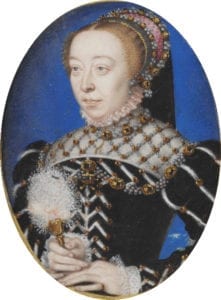Julius P. Bonello
Peoria, Illinois, United States
 |
 |
| Photos by Julius Bonello |
Dynasties beget legacies. An enduring legacy is important to all great leaders. However, dynasties need time—time to accomplish major national objectives or memorable feats. Today that is why our elected officials, to pass on a lasting legacy, spend much of their time campaigning for their next election. In ancient and medieval history, passing on an eminent position to heirs was important. If childless, as in the case of Julius Caesar, relatives were often adopted to pass on a legacy. In some cases, the populace of the empire would not only expect, but also demand an heir. This led to enormous pressure on a childless royal family, especially the wife or the queen.
In sixteenth century France, Henry II, the tenth Valois king, was expected to carry on its 200-year dynasty. After ten years of childless marriage, rumors begin to spread of his wife’s infertility and the idea of a divorce surfaced throughout France. The penalty for a barren queen could also include annulment, banishment, or life in a convent. The royal couple had to do something.
The King
Henry II was born March 31, 1519, the fourth child and second son of Francis I, King of France. France at that time was in the midst of the Italian Wars (1494-1559). In 1525, France suffered its greatest defeat at the Battle of Pavia. Francis was taken prisoner and incarcerated in Spain. By the Madrid Treaty, Francis was forced to concede lands in Italy and Flanders, and in order to be released he had to make a very unfatherly, Machiavellian move. To return to Paris, he had to exchange his children for his incarceration in Spain. Henry and his older brother would be held captive in Madrid for four years. Henry was seven.
Upon returning to France, a twelve-year-old Henry, morose and unable to speak fluent French, was assigned a thirty-year-old female mentor. At first a very maternal relationship, five years later beautiful Diane de Poitiers, with porcelain-like skin and soon to be widowed, would become his lifelong mistress.
Despite this developing relationship, two years later Francis I was looking for a wife for Henry. Because Henry was the second son, his marriage was not looked upon as being an important political alliance. Trying to keep a foot in Italy after his devastating defeat at Pavia, and in hope of obtaining a dowry to enrich his war-torn depleted coffers, Francis I chose Catherine of the Medici family of Florence, Italy, the richest and most influential family in the world. She was fourteen.
The Queen
Catherine de’ Medici was born April 13, 1519. With the death of her parents, Catherine was orphaned at the age of three weeks. Luckily her uncle, Pope Leo X, assumed guardianship and moved her to Rome to be brought up and taught by her aunt. The sacking of Rome in 1527 forced Catherine and her aunt to return to Florence for their safety. An uprising in Florence against the Vatican forced Catherine to leave the palace and enter a convent. There she was semi-incarcerated for the next three years.
 |
| Attributed to François Clouet – 1. (Hearn, Karen, ed. Dynasties: Painting in Tudor and Jacobean England 1530-1630. New York: Rizzoli, 1995. ISBN 0-8478-1940-X.)2. Victoria and Albert Museum, Public Domain. |
In 1530 Pope Clement VII, another uncle of Catherine’s, attacked Florence with 30,000 men. Catherine was released and returned to Rome. Later that month, Francis I arranged the marriage between Catherine and his second son Henry, Duke of Orleans. The promised dowry, consisting of money, jewelry, and four Italian cities was substantial.
The wedding took place in Marseille, France on October 28, 1533. Participants at the wedding remarked that her gown was so richly bejeweled it was impossible to tell its color. That night the king actually watched the couple consummate the marriage and later told the court “each had shown valor in the joust.” Even her uncle the Pope dropped in on them in the morning to see if all was well.
Sadly for Catherine, this “marital bliss” lasted only one year. Her uncle Pope Clement VII died the following year and the new pope refused to recognize Catherine’s substantial dowry, leaving the King of France with a chest empty of Medici gold. Henry was heard to remark, “The girl has come to me stark naked.” The French populace nicknamed her the “Merchant’s Daughter,” and her new husband began his lifelong romantic relationship with the beautiful and confident Diane, which left Catherine rather powerless to intervene. Although she was the love of his life, Diane insisted that Catherine share Henry’s bed to produce heirs. Alas, royal babies were not seen for quite some time.
Upon the death of his older brother in 1536, Henry became the Dauphin of France. Along with the new title, pressure to produce heirs became paramount. Of course, the fault of the couple’s infertility could not possibly be Henry’s. He was French. Obviously, the reason for the lack of infertility must rest with the Italian queen, and talk of divorce began to surface.
At first, Catherine went to King Francis. Throwing herself at his feet sobbing, Catherine told the King that she would stand aside for a new bride that would bear Henry children. Francis, moved to tears declared, “My child, it is God’s will that you should be my daughter and the wife of the Dauphin. So be it.” Catherine received her reprieve, but she feared it would only be temporary.
The first obstacle to fertility was that Henry was not blind. Catherine was notoriously unattractive. One ambassador described Catherine’s face when unveiled resembled nothing so much as a “plank of wood.” She was so homely that Henry visited Diane’s chamber first to become sexually aroused before engaging in intercourse with his wife. He would then retire and sleep that night in Diane’s bedroom.
Catherine went on to pursue multiple interventions by surrounding herself with doctors, astrologers, magicians, alchemists, and seers. She made use of tarot cards and charms and resorted to medieval remedies. She drank large amounts of mule urine, because the current wisdom was that it would provide a primitive form of inoculation against sterility. She also refused to ride a mule because it is sterile. She drank the urine of pregnant animals, consumed the powdered sexual organs of boars and cats, and mixed many different herbs in her food and wine. Another remedy was to drink a mixture of unicorn horn and ivory in water. Due to the scarcity of unicorn horns, she could substitute a recipe of mare’s milk, rabbit’s blood, and sheep’s urine. Another was to consume the left hind paw of a weasel mixed with vinegar. She was told to wear over her “source of life” organ a soft, warm, extremely noisome poultice made of ground stag antlers and cow dung. It seems incredible that Henry would want to get close enough to attempt conceiving offspring.
However, she did not stop there. The desperate Catherine, against the advice of her female attendants, had two Italian carpenters drill holes in Diane’s bedroom ceiling. She could watch and learn from her husband and his mistress’s sexual jousting to better her lovemaking skills. After watching through tear-filled eyes, she saw something that suggested to her that she and Henry were doing something quite different when they lay together.
 |
| Photo by Julius Bonello |
In 1537, Henry made claim to being the father of an illegitimate daughter during one of his warring forays into Italy, and he bragged that he was with the woman for one night only, adding insult to injury. In 1538, the child was legitimized by Henry, thereby ensuring proof of his ability to father a child. She received the name Diane De France in honor of his mistress Diane.
Despite this claim by Henry, today’s historians believe that the cause of the infertility was Henry’s congenital penile malformation. Two physicians who examined and diagnosed Henry with hypospadias gave details of Henry’s problem. This was mentioned by a sixteenth-century biographer and again by a seventeenth-century biographer who wrote, “Nothing is commoner in surgical experience than such a malformation as a prince’s which gave rise to a jest of the ladies of the court . . .”
Hypospadias is a condition in which the opening of the penis is on the underside rather than the tip. It is often present with chordee, another congenital condition where the penis usually curves downward. These can lead to infertility from failure of semen to reach the cervix due to either improper meatal position or inability to achieve penetration. The severity of Henry’s malformation cannot be determined from the literature. However, the condition was severe enough to warrant an examination by a physician. After diagnosing Henry’s anomaly, the physician recommended trying different coital positions and gave Catherine pills of myrrh.
Diane, well aware of Henry’s condition and happy to continue to be his mistress, advised the couple to engage in sexual relations “a levrette” (a female greyhound). One can imagine the joy in Paris when in the summer of 1543, Catherine was found to be pregnant. On January 19, 1544, Catherine gave birth to her son, whom she would name Francis in honor of his grandfather. Diane was in attendance at the birth.
Catherine went on to bear ten children. Hercules, Catherine’s eighth child and the last to survive, was born in May 1554. She gave birth to twins in 1556, who both died. Catherine, a firm believer in astrology, invited Nostradamus to visit her in Paris that same year. Nostradamus predicted that all of her sons would be kings, but that she would herself outlive them all. As it turned out, he was only off by one. One of the sons, Louis, died in infancy. Francis became Francis II, Charles would become Charles IX, and her sixth child would become Henry III. She acted as regent for her two sons and played a key role in Henry III’s reign before her death in 1589, seven months before Henry’s assassination.
But what of Henry II? He met an untimely death in 1559.
How you ask? Well, that is another story.
References
- Herman, E. (2011). Sex with kings: 500 years of adultery, power, rivalry, and revenge. New York: Barnes and Noble.
- Frieda, L. (2006). Catherine de Medici: Renaissance queen of France. New York: Harper Perennial.
- Catherine de’ Medici. (n.d.). Retrieved from http://www.newadvent.org/cathen/03443a.htm.
- Gordetsky, J., Rabinowitz, R., & O’Brien, J. (2009). The “infertility” of Catherine de Medici and its influence on 16th century France. The Canadian Journal of Urology, 16(2), 4584–4588.
- Thériault, A., & Thériault, A. (2018, October 11). Queens of Infamy: The Reign of Catherine de’ Medici. Retrieved from https://longreads.com/2018/10/11/catherine-de-medici-reign/.
- Lewis, H., Lewis, H., & Lewis, H. (2016, May 19). Me and my monarch: Catherine de Medici. Retrieved from https://www.newstatesman.com/2016/05/me-and-my-monarch-catherine-de-medici.
JULIUS P. BONELLO, MD, FACS, has taught students and residents for the last forty-five years at the University of Illinois College of Medicine. He now holds the title of Professor Emeritus of Clinical Surgery. He has eight children and lives in Peoria, Illinois with his wife of thirty-three years.
Highlighted in Frontispiece Volume 12, Issue 3 – Summer 2020
Winter 2020 | Sections | History Essays

Leave a Reply